Extraterrestrial atmosphere: Difference between revisions
m Reverted edits by 173.95.172.151 (talk) to last version by Xover |
Cyberbot II (talk | contribs) Rescuing 1 sources, flagging 0 as dead, and archiving 32 sources. #IABot |
||
| Line 29: | Line 29: | ||
[[File:Mars atmosphere 2.jpg|thumb|right|200px|The tenuous atmosphere of Mars visible on the horizon.]] |
[[File:Mars atmosphere 2.jpg|thumb|right|200px|The tenuous atmosphere of Mars visible on the horizon.]] |
||
[[File:mars pits 1999.gif|thumb|left|200px|Pits in south polar ice cap, MGS 1999, NASA]] |
[[File:mars pits 1999.gif|thumb|left|200px|Pits in south polar ice cap, MGS 1999, NASA]] |
||
Between the [[Viking program|Viking]] and [[Mars Global Surveyor]] missions, Mars saw "Much colder (10-20 K) global atmospheric temperatures were observed during the 1997 versus 1977 perihelion periods" and "that the global aphelion atmosphere of Mars is colder, less dusty, and cloudier than indicated by the established Viking climatology,"<ref>{{cite journal | title=An intercomparison of ground-based millimeter, MGS TES, and Viking atmospheric temperature measurements: Seasonal and interannual variability of temperatures and dust loading in the global Mars atmosphere | journal=Journal of Geophysical Research | last=Clancy |first=R. | volume=105 | issue=4 | date=April 25, 2000 | pages=9553–9571|bibcode = 2000JGR...105.9553C |doi = 10.1029/1999JE001089 }}</ref> with "generally colder atmospheric temperatures and lower dust loading in recent decades on Mars than during the Viking Mission."<ref>{{cite journal | title=Mars Reconnaissance Orbiter Mars Color Imager (MARCI): Instrument Description, Calibration, and Performance | journal=Journal of Geophysical Research | author=Bell, J | display-authors=etal | volume=114 | issue=8 | date=August 28, 2009 | doi = 10.1029/2008je003315 | bibcode=2009JGRE..114.8S92B}}</ref> The [[Mars Reconnaissance Orbiter]], though spanning a much shorter dataset, shows no warming of planetary average temperature, and a possible cooling. "[[Mars climate sounder|MCS]] MY 28 temperatures are an average of 0.9 (daytime) and 1.7 K (night- time) cooler than [[Thermal emission spectrometer|TES]] MY 24 measurements."<ref>{{cite journal | author=Bandfield, J. L. | display-authors=etal | title=Radiometric Comparison of Mars Climate Sounder and Thermal Emission Spectrometer Measurements | journal=Icarus | volume=225 | date=2013 | pages=28–39 | doi=10.1016/j.icarus.2013.03.007 | bibcode=2013Icar..225...28B}}</ref> Locally and regionally, however, changes in [[Swiss cheese features|pits]] in the layer of frozen [[carbon dioxide]] at the Martian south pole observed between 1999 and 2001 suggest the [[Planum Australe|south polar ice cap]] is shrinking. More recent observations indicate that Mars' south pole is continuing to melt. "It's evaporating right now at a prodigious rate," says [[Michael C. Malin|Michael Malin]], principal investigator for the Mars Orbiter Camera.<ref>{{cite web | title = MGS sees changing face of Mars | last = Reddy | first = Francis | publisher = [[Astronomy (magazine)|Astronomy]] | url = http://www.astronomy.com/asy/default.aspx?c=a&id=3503 | date = 2005-09-23 | accessdate = 2007-02-22}}</ref> The pits in the ice are growing by about 3 meters (9.8 ft) per year. Malin states that conditions on [[Mars]] are not currently conductive to the formation of new ice. A web site has suggested that this indicates a "climate change in progress" on [[Mars]].<ref>{{cite web| |
Between the [[Viking program|Viking]] and [[Mars Global Surveyor]] missions, Mars saw "Much colder (10-20 K) global atmospheric temperatures were observed during the 1997 versus 1977 perihelion periods" and "that the global aphelion atmosphere of Mars is colder, less dusty, and cloudier than indicated by the established Viking climatology,"<ref>{{cite journal | title=An intercomparison of ground-based millimeter, MGS TES, and Viking atmospheric temperature measurements: Seasonal and interannual variability of temperatures and dust loading in the global Mars atmosphere | journal=Journal of Geophysical Research | last=Clancy |first=R. | volume=105 | issue=4 | date=April 25, 2000 | pages=9553–9571|bibcode = 2000JGR...105.9553C |doi = 10.1029/1999JE001089 }}</ref> with "generally colder atmospheric temperatures and lower dust loading in recent decades on Mars than during the Viking Mission."<ref>{{cite journal | title=Mars Reconnaissance Orbiter Mars Color Imager (MARCI): Instrument Description, Calibration, and Performance | journal=Journal of Geophysical Research | author=Bell, J | display-authors=etal | volume=114 | issue=8 | date=August 28, 2009 | doi = 10.1029/2008je003315 | bibcode=2009JGRE..114.8S92B}}</ref> The [[Mars Reconnaissance Orbiter]], though spanning a much shorter dataset, shows no warming of planetary average temperature, and a possible cooling. "[[Mars climate sounder|MCS]] MY 28 temperatures are an average of 0.9 (daytime) and 1.7 K (night- time) cooler than [[Thermal emission spectrometer|TES]] MY 24 measurements."<ref>{{cite journal | author=Bandfield, J. L. | display-authors=etal | title=Radiometric Comparison of Mars Climate Sounder and Thermal Emission Spectrometer Measurements | journal=Icarus | volume=225 | date=2013 | pages=28–39 | doi=10.1016/j.icarus.2013.03.007 | bibcode=2013Icar..225...28B}}</ref> Locally and regionally, however, changes in [[Swiss cheese features|pits]] in the layer of frozen [[carbon dioxide]] at the Martian south pole observed between 1999 and 2001 suggest the [[Planum Australe|south polar ice cap]] is shrinking. More recent observations indicate that Mars' south pole is continuing to melt. "It's evaporating right now at a prodigious rate," says [[Michael C. Malin|Michael Malin]], principal investigator for the Mars Orbiter Camera.<ref>{{cite web | title = MGS sees changing face of Mars | last = Reddy | first = Francis | publisher = [[Astronomy (magazine)|Astronomy]] | url = http://www.astronomy.com/asy/default.aspx?c=a&id=3503 | date = 2005-09-23 | accessdate = 2007-02-22}}</ref> The pits in the ice are growing by about 3 meters (9.8 ft) per year. Malin states that conditions on [[Mars]] are not currently conductive to the formation of new ice. A web site has suggested that this indicates a "climate change in progress" on [[Mars]].<ref>{{cite web|url=http://mpfwww.jpl.nasa.gov/mgs/newsroom/20050920a.html |title=Orbiter's Long Life Helps Scientists Track Changes on Mars |date=2005-09-20 |publisher=[[NASA]] |accessdate=2007-05-09 |deadurl=yes |archiveurl=https://web.archive.org/20070430085506/http://mpfwww.jpl.nasa.gov:80/mgs/newsroom/20050920a.html |archivedate=April 30, 2007 }}</ref> Multiple studies suggests this may be a local phenomenon rather than a global one.<ref>{{cite journal | author=Liu, J., Richardson, M. | title=An assessment of the global, seasonal, and interannual spacecraft record of Martian climate in the thermal infrared | journal=Journal of Geophysical Research | volume=108 | issue= 8 |date=August 2003 | doi = 10.1029/2002je001921 | bibcode=2003JGRE..108.5089L}}</ref> |
||
Colin Wilson has proposed that the observed variations are caused by irregularities in the orbit of Mars.<ref name="NG Mars">{{cite web| title=Mars Melt Hints at Solar, Not Human, Cause for Warming, Scientist Says | url=http://news.nationalgeographic.com/news/2007/02/070228-mars-warming.html | last=Ravilious | publisher=[[National Geographic Society]] | first=Kate | date=2007-03-28 | accessdate=2007-05-09}}</ref> William Feldman speculates the warming could be because Mars might be coming out of an [[ice age]].<ref>{{cite web| title=Mars Emerging from Ice Age, Data Suggest | url=http://www.space.com/scienceastronomy/mars_ice-age_031208.html | publisher=[[Space.com]] | date=2003-12-08 | accessdate=2007-05-10}}</ref> Other scientists state the warming may be a result of [[albedo]] changes from dust storms.<ref>{{Cite journal | first=Lori K. | last=Fenton |display-authors=etal | title=Global warming and climate forcing by recent of albedo changes on Mars | date=2007-04-05 | journal=[[Nature (journal)|Nature]] | volume=446 | issue=7136 | doi=10.1038/nature05718 | url=http://humbabe.arc.nasa.gov/~fenton/pdf/fenton/nature05718.pdf | pages=646–649 | accessdate=2007-05-09 | pmid=17410170|bibcode = 2007Natur.446..646F }}</ref><ref name="NG Mars2">{{cite web| title=Mars Warming Due to Dust Storms, Study Finds | url=http://news.nationalgeographic.com/news/2007/04/070404-mars-warming.html | last=Ravilious | publisher=[[National Geographic Society]] | first=Kate | date=2007-04-04 | accessdate=2007-05-19}}</ref> The study predicts the planet could continue to warm, as a result of [[positive feedback]].<ref name="NG Mars2"/> |
Colin Wilson has proposed that the observed variations are caused by irregularities in the orbit of Mars.<ref name="NG Mars">{{cite web| title=Mars Melt Hints at Solar, Not Human, Cause for Warming, Scientist Says | url=http://news.nationalgeographic.com/news/2007/02/070228-mars-warming.html | last=Ravilious | publisher=[[National Geographic Society]] | first=Kate | date=2007-03-28 | accessdate=2007-05-09}}</ref> William Feldman speculates the warming could be because Mars might be coming out of an [[ice age]].<ref>{{cite web| title=Mars Emerging from Ice Age, Data Suggest | url=http://www.space.com/scienceastronomy/mars_ice-age_031208.html | publisher=[[Space.com]] | date=2003-12-08 | accessdate=2007-05-10}}</ref> Other scientists state the warming may be a result of [[albedo]] changes from dust storms.<ref>{{Cite journal | first=Lori K. | last=Fenton |display-authors=etal | title=Global warming and climate forcing by recent of albedo changes on Mars | date=2007-04-05 | journal=[[Nature (journal)|Nature]] | volume=446 | issue=7136 | doi=10.1038/nature05718 | url=http://humbabe.arc.nasa.gov/~fenton/pdf/fenton/nature05718.pdf | pages=646–649 | accessdate=2007-05-09 | pmid=17410170|bibcode = 2007Natur.446..646F }}</ref><ref name="NG Mars2">{{cite web| title=Mars Warming Due to Dust Storms, Study Finds | url=http://news.nationalgeographic.com/news/2007/04/070404-mars-warming.html | last=Ravilious | publisher=[[National Geographic Society]] | first=Kate | date=2007-04-04 | accessdate=2007-05-19}}</ref> The study predicts the planet could continue to warm, as a result of [[positive feedback]].<ref name="NG Mars2"/> |
||
Revision as of 16:12, 20 January 2016
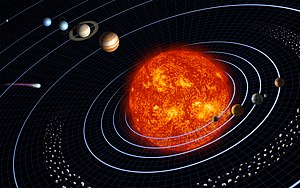
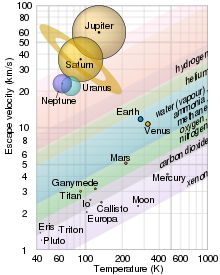
The study of extraterrestrial atmospheres is an active field of research,[1] both as an aspect of astronomy and to gain insight into Earth's atmosphere.[2] In addition to Earth, many of the other astronomical objects in the Solar System have atmospheres. These include all the gas giants, as well as Mars, Venus, and Pluto. Several moons and other bodies also have atmospheres, as do comets and the Sun. There is evidence that extrasolar planets can have an atmosphere. Comparisons of these atmospheres to one another and to Earth's atmosphere broaden our basic understanding of atmospheric processes such as the greenhouse effect, aerosol and cloud physics, and atmospheric chemistry and dynamics.
Planets
Inner planets
Mercury
Due to its small size (and thus its small gravity), Mercury has no substantial atmosphere. Its extremely thin atmosphere mostly consists of a small amount of helium and traces of sodium, potassium, and oxygen. These gases derive from the solar wind, radioactive decay, meteor impacts, and breakdown of Mercury's crust.[3][4] Mercury's atmosphere is not stable and is constantly being refreshed because of its atoms escaping into space as a result of the planet's heat.
Venus

Venus' atmosphere is mostly composed of carbon dioxide. It contains minor amounts of nitrogen and other trace elements, including compounds based on hydrogen, nitrogen, sulfur, carbon, and oxygen. The atmosphere of Venus is much hotter and denser than that of Earth, though shallower. As greenhouse gases warm a lower atmosphere, they cool the upper atmosphere, leading to compact thermospheres.[5][6] By some definitions, Venus has no stratosphere.[citation needed]
The troposphere begins at the surface and extends up to an altitude of 65 kilometres (an altitude at which the mesosphere has already been reached on Earth). At the top of the troposphere, temperature and pressure reach Earth-like levels. Winds at the surface are a few metres per second, reaching 70 m/s or more in the upper troposphere. The stratosphere and mesosphere extend from 65 km to 95 km in height. The thermosphere and exosphere begin at around 95 kilometres, eventually reaching the limit of the atmosphere at about 220 to 250 km.
The air pressure at Venus' surface is about 92 times that of the Earth. The enormous amount of CO2 in the atmosphere creates a strong greenhouse effect, raising the surface temperature to around 470 °C, hotter than that of any other planet in the Solar System.
Mars
The Martian atmosphere is very thin and composed mainly of carbon dioxide, with some nitrogen and argon. The average surface pressure on Mars is 0.6-0.9 kPa, compared to about 101 kPa for Earth. This results in a much lower atmospheric thermal inertia, and as a consequence Mars is subject to strong thermal tides that can change total atmospheric pressure by up to 10%. The thin atmosphere also increases the variability of the planet's temperature. Martian surface temperatures vary from lows of approximately −140 °C (−220 °F) during the polar winters to highs of up to 20 °C (70 °F) in summers.

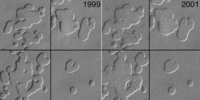
Between the Viking and Mars Global Surveyor missions, Mars saw "Much colder (10-20 K) global atmospheric temperatures were observed during the 1997 versus 1977 perihelion periods" and "that the global aphelion atmosphere of Mars is colder, less dusty, and cloudier than indicated by the established Viking climatology,"[7] with "generally colder atmospheric temperatures and lower dust loading in recent decades on Mars than during the Viking Mission."[8] The Mars Reconnaissance Orbiter, though spanning a much shorter dataset, shows no warming of planetary average temperature, and a possible cooling. "MCS MY 28 temperatures are an average of 0.9 (daytime) and 1.7 K (night- time) cooler than TES MY 24 measurements."[9] Locally and regionally, however, changes in pits in the layer of frozen carbon dioxide at the Martian south pole observed between 1999 and 2001 suggest the south polar ice cap is shrinking. More recent observations indicate that Mars' south pole is continuing to melt. "It's evaporating right now at a prodigious rate," says Michael Malin, principal investigator for the Mars Orbiter Camera.[10] The pits in the ice are growing by about 3 meters (9.8 ft) per year. Malin states that conditions on Mars are not currently conductive to the formation of new ice. A web site has suggested that this indicates a "climate change in progress" on Mars.[11] Multiple studies suggests this may be a local phenomenon rather than a global one.[12]
Colin Wilson has proposed that the observed variations are caused by irregularities in the orbit of Mars.[13] William Feldman speculates the warming could be because Mars might be coming out of an ice age.[14] Other scientists state the warming may be a result of albedo changes from dust storms.[15][16] The study predicts the planet could continue to warm, as a result of positive feedback.[16]
Gas giants
The four outer planets of the Solar System are gas giants. They share some atmospheric commonalities. All have atmospheres that are mostly hydrogen and helium and that blend into the liquid interior at pressures greater than the critical pressure, so that there is no clear boundary between atmosphere and body.
Jupiter
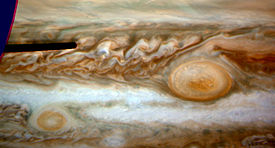
Jupiter's upper atmosphere is composed of about 75% hydrogen and 24% helium by mass, with the remaining 1% consisting of other elements. The interior contains denser materials such that the distribution is roughly 71% hydrogen, 24% helium and 5% other elements by mass. The atmosphere contains trace amounts of methane, water vapor, ammonia, and silicon-based compounds. There are also traces of carbon, ethane, hydrogen sulfide, neon, oxygen, phosphine, and sulfur. The outermost layer of the atmosphere contains crystals of frozen ammonia, possibly underlaid by a thin layer of water.
Jupiter is covered with a cloud layer about 50 km deep. The clouds are composed of ammonia crystals and possibly ammonium hydrosulfide. The clouds are located in the tropopause and are arranged into bands of different latitudes, known as tropical regions. These are sub-divided into lighter-hued zones and darker belts. The interactions of these conflicting circulation patterns cause storms and turbulence. The best-known feature of the cloud layer is the Great Red Spot, a persistent anticyclonic storm located 22° south of the equator that is larger than Earth. In 2000, an atmospheric feature formed in the southern hemisphere that is similar in appearance to the Great Red Spot, but smaller in size. The feature was named Oval BA, and has been nicknamed Red Spot Junior.
Observations of the Red Spot Jr. storm suggest Jupiter could be in a period of global climate change.[17][18] This is hypothesized to be part of an approximately 70 year global climate cycle, characterized by the relatively rapid forming and subsequent slow erosion and merging of cyclonic and anticyclonic vortices in Jupiter's atmosphere. These vortices facilitate the heat exchange between poles and equator. If they have sufficiently eroded, heat exchange is strongly reduced and regional temperatures may shift by as much as 10 K, with the poles cooling down and the equator region heating up. The resulting large temperature differential destabilizes the atmosphere and thereby leads to the creation of new vortices.[19][20]
Saturn
The outer atmosphere of Saturn consists of about 93.2% hydrogen and 6.7% helium. Trace amounts of ammonia, acetylene, ethane, phosphine, and methane have also been detected. As with Jupiter, the upper clouds on Saturn are composed of ammonia crystals, while the lower level clouds appear to be composed of either ammonium hydrosulfide (NH4SH) or water.
The Saturnian atmosphere is in several ways similar to that of Jupiter. It exhibits a banded pattern similar to Jupiter's, and occasionally exhibits long-lived ovals caused by storms. A storm formation analogous to Jupiter's Great Red Spot, the Great White Spot, is a short-lived phenomenon that forms with a roughly 30-year periodicity. It was last observed in 1990. However, the storms and the band pattern are less visible and active than those of Jupiter, due to the overlying ammonia hazes in Saturn's troposphere.
Saturn's atmosphere has several unusual features. Its winds are among the Solar System's fastest, with Voyager data indicating peak easterly winds of 500 m/s. It is also the only planet with a warm polar vortex, and is the only planet other than Earth where eyewall clouds have been observed in hurricane-like structures.
Uranus
The atmosphere of Uranus is composed primarily of gas and various ices. It is about 83% hydrogen, 15% helium, 2% methane and traces of acetylene. Like Jupiter and Saturn, Uranus has a banded cloud layer, although this is not readily visible without enhancement of visual images of the planet. Unlike the larger gas giants, the low temperatures in the upper Uranian cloud layer, down to 50 K, causes cloud formation from methane rather than ammonia.
Less storm activity has been observed in the Uranian atmosphere than in those of Jupiter or Saturn, due to the overlying methane and acetylene hazes in its atmosphere making the planet look like a bland, light blue globe.[citation needed] Images taken in 1997 with the Hubble Space Telescope showed storm activity in that part of the atmosphere emerging from the 25-year-long Uranian winter. The general lack of storm activity may be related to the lack of an internal energy generation mechanism for Uranus, a feature unique among the gas giants.[21]
Neptune

The atmosphere of Neptune is similar to that of Uranus. It is about 80% hydrogen, 19% helium, and 1.5% methane. However the weather activity on Neptune is much more active, and its atmosphere is much bluer than that of Uranus. The upper levels of the atmosphere reach temperatures of about 55 K, giving rise to methane clouds in its troposphere, which gives the planet its ultramarine color. Temperatures rise steadily deeper inside the atmosphere.
Neptune has extremely dynamic weather systems, including the highest wind speeds in the Solar System, thought to be powered by the flow of internal heat. Typical winds in the banded equatorial region can possess speeds of around 350 m/s, while storm systems can have winds reaching up to around 900 m/s, nearly the speed of sound in Neptune's atmosphere. Several large storm systems have been identified, including the Great Dark Spot, a cyclonic storm system the size of Eurasia, the Scooter, a white cloud group further south than the Great Dark Spot, and the Wizard's eye/Dark Spot 2, a southern cyclonic storm.
Neptune, the farthest planet from Earth, has increased in brightness since 1980. Neptune's brightness is statistically correlated with its stratospheric temperature. Hammel and Lockwood hypothesize that the change in brightness includes a solar variation component as well as a seasonal component, though they did not find a statistically significant correlation with solar variation. They propose that the resolution of this issue will be clarified by brightness observations in the next few years: forcing by a change in sub-solar latitude should be reflected in a flattening and decline of brightness, while solar forcing should be reflected in a flattening and then resumed rise of brightness.[22]
Other bodies in the Solar System
Natural satellites
Seven of the many natural satellites in the Solar System are known to have atmospheres: Europa, Io, Callisto, Enceladus, Ganymede, Titan, and Triton. Ganymede and Europa both have very tenuous oxygen atmospheres, thought to be produced by radiation splitting the water ice present on the surface of these moons into hydrogen and oxygen. Io has an extremely thin atmosphere consisting mainly of sulfur dioxide (SO
2), arising from volcanism and sunlight-driven sublimation of surface sulfur dioxide deposits. The atmosphere of Enceladus is also extremely thin and variable, consisting mainly of water vapor, nitrogen, methane, and carbon dioxide vented from the moon's interior through cryovolcanism. The extremely thin carbon dioxide atmosphere of Callisto is thought to be replenished by sublimation from surface deposits.
Titan
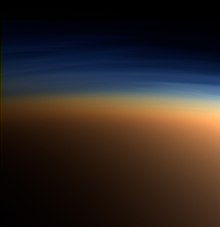
Titan has by far the densest atmosphere of any moon. The Titanean atmosphere is in fact denser than Earth's, with a surface pressure of 147 kPa, one and a half times that of the Earth. The atmosphere is 98.4% nitrogen, with the remaining 1.6% composed of methane and trace amounts of other gases such as hydrocarbons (including ethane, diacetylene, methylacetylene, cyanoacetylene, acetylene, propane), argon, carbon dioxide, carbon monoxide, cyanogen, hydrogen cyanide and helium. The hydrocarbons are thought to form in Titan's upper atmosphere in reactions resulting from the breakup of methane by the Sun's ultraviolet light, producing a thick orange smog. Titan has no magnetic field and sometimes orbits outside Saturn's magnetosphere, directly exposing it to the solar wind. This may ionize and carry away some molecules from the top of the atmosphere.
Titan's atmosphere supports an opaque cloud layer that obscures Titan's surface features at visible wavelengths. The haze that can be seen in the picture to the right contributes to the moon's anti-greenhouse effect and lowers the temperature by reflecting sunlight away from the satellite. The thick atmosphere blocks most visible wavelength light from the Sun and other sources from reaching Titan's surface.
Triton
Triton, Neptune's largest moon, has a tenuous nitrogen atmosphere with small amounts of methane. Tritonian atmospheric pressure is about 1Pa. The surface temperature is at least 35.6 K, with the nitrogen atmosphere in equilibrium with nitrogen ice on Triton's surface.
Triton has increased in absolute temperature by 5% since 1989 to 1998.[23][24] A similar rise of temperature on Earth would be equal to about 11 °C (20 °F) increase in temperature in nine years. "At least since 1989, Triton has been undergoing a period of global warming. Percentage-wise, it's a very large increase," said James L. Elliot, who published the report.[23]
Triton is approaching an unusually warm summer season that only happens once every few hundred years. Elliot and his colleagues believe that Triton's warming trend could be driven by seasonal changes in the absorption of solar energy by its polar ice caps. One suggestion for this warming is that it is a result of frost patterns changing on its surface. Another is that ice albedo has changed, allowing for more heat from the Sun to be absorbed.[25] Bonnie J. Buratti et al. argue the changes in temperature are a result of deposition of dark, red material from geological processes on the moon, such as massive venting. Because Triton's Bond albedo is among the highest within the Solar System, it is sensitive to small variations in spectral albedo.[26]
Pluto
Near-sunset view includes several layers of atmospheric haze.
Pluto has an extremely thin atmosphere that consists of nitrogen, methane, and carbon monoxide, derived from the ices on its surface.[27] Two models [28][29] show that the atmosphere does not completely freeze and collapse when Pluto moves further from the Sun on its extremely elliptical orbit. However, some do. Pluto needs 248 years for one complete orbit, and has been observed for less than one third of that time. It has an average distance of 39 AU from the Sun, hence in-depth data from Pluto is sparse and difficult to gather. Temperature is inferred indirectly for Pluto; when it passes in front of a star, observers note how fast the light drops off. From this, they deduce the density of the atmosphere, and that is used as an indicator of temperature.

One such occultation events happened in 1988. Observations of a second occulation on August 20, 2002 suggest that Pluto's atmospheric pressure has tripled, indicating a warming of about 2 °C (3.6 °F),[30][31] as predicted by Hansen and Paige.[32] The warming is "likely not connected with that of the Earth," says Jay Pasachoff.[33] One astronomer has speculated the warming may be a result of eruptive activity, but it is more likely Pluto's temperature is heavily influenced by its elliptical orbit. It was closest to the Sun in 1989 (perihelion) and has slowly receded since. If it has any thermal inertia, it is expected to warm for a while after it passes perihelion.[34] "This warming trend on Pluto could easily last for another 13 years," says David J. Tholen.[30] It has also been suggested that a darkening of surface ice may also be the cause, but additional data and modeling is needed. Frost distribution on the surface of Pluto is significantly affected by the dwarf planet's high obliquity.[35]
In January 2006, NASA launched New Horizons, a spacecraft set to study Pluto.[36] New Horizons flew past Pluto in July, 2015.[37]
Comets
The coma of a comet is a very large but very tenuous atmosphere of dust and gas around the cometary nucleus. It can be larger than the Sun and is generally made up of ice and dust, but the composition varies depending on the composition of the comet.
Extrasolar planets
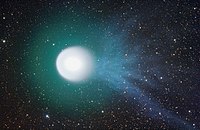
Several planets outside the Solar System (exoplanets) have been observed to have atmospheres. At the present time, all atmosphere detections are of hot Jupiters or hot Neptunes that orbit very close to their star and thus have heated and extended atmospheres. Observations of exoplanet atmospheres are of two types. First, transmission photometry or spectra detect the light that passes through a planet's atmosphere as it transits in front of its star. Second, the direct emission from a planet atmosphere may be detected by differencing the star plus planet light obtained during most of the planet's orbit with the light of just the star during secondary eclipse (when the exoplanet is behind its star).[citation needed]
The first observed extrasolar planetary atmosphere was made in 2001.[38] Sodium in the atmosphere of the planet HD 209458 b was detected during a set of four transits of the planet across its star. Later observations with the Hubble Space Telescope showed an enormous ellipsoidal envelope of hydrogen, carbon and oxygen around the planet. This envelope reaches temperatures of 10,000 K. The planet is estimated to be losing (1-5)×108 kg of hydrogen per second. This type of atmosphere loss may be common to all planets orbiting Sun-like stars closer than around 0.1 AU.[39] In addition to hydrogen, carbon, and oxygen, HD 209458 b is thought to have water vapor in its atmosphere.[40][41][42] Water vapour has also been observed in the atmosphere of HD 189733 b,[43] another hot gas giant planet.
In October 2013, the detection of clouds in the atmosphere of Kepler-7b was announced,[44][45] and, in December 2013, also in the atmospheres of GJ 436 b and GJ 1214 b.[46][47][48][49]
Stars
The stellar atmosphere is the outer region of the volume of a star, lying above the stellar core, radiation zone and convection zone. During a total solar eclipse, the photosphere of the Sun is obscured, revealing its atmosphere's other layers.[50] Observed during eclipse, the Sun's chromosphere appears (briefly) as a thin pinkish arc,[51] and its corona is seen as a tufted halo. The same phenomenon in eclipsing binaries can make the chromosphere of giant stars visible.[52]
See also
References
- ^ "Department of Atmospheric Science, University of Washington". Retrieved 2007-05-24.
- ^ "NASA GISS: Research in Planetary Atmospheres". Retrieved 2007-05-24.
- ^ Atmosphere of Mercury
- ^ ESA Science & Technology: Mercury Atmosphere
- ^ Picone, J.; Lean, J. (2005). "Global Change in the Thermosphere: Compelling Evidence of a Secular Decrease in Density". 2005 NRL Review: 225–227.
- ^ Lewis, H.; et al. (April 2005). "Response of the Space Debris Environment to Greenhouse Cooling". Proceedings of the 4th European Conference on Space Debris: 243.
- ^ Clancy, R. (April 25, 2000). "An intercomparison of ground-based millimeter, MGS TES, and Viking atmospheric temperature measurements: Seasonal and interannual variability of temperatures and dust loading in the global Mars atmosphere". Journal of Geophysical Research. 105 (4): 9553–9571. Bibcode:2000JGR...105.9553C. doi:10.1029/1999JE001089.
- ^ Bell, J; et al. (August 28, 2009). "Mars Reconnaissance Orbiter Mars Color Imager (MARCI): Instrument Description, Calibration, and Performance". Journal of Geophysical Research. 114 (8). Bibcode:2009JGRE..114.8S92B. doi:10.1029/2008je003315.
- ^ Bandfield, J. L.; et al. (2013). "Radiometric Comparison of Mars Climate Sounder and Thermal Emission Spectrometer Measurements". Icarus. 225: 28–39. Bibcode:2013Icar..225...28B. doi:10.1016/j.icarus.2013.03.007.
- ^ Reddy, Francis (2005-09-23). "MGS sees changing face of Mars". Astronomy. Retrieved 2007-02-22.
- ^ "Orbiter's Long Life Helps Scientists Track Changes on Mars". NASA. 2005-09-20. Archived from the original on April 30, 2007. Retrieved 2007-05-09.
{{cite web}}: Unknown parameter|deadurl=ignored (|url-status=suggested) (help) - ^ Liu, J., Richardson, M. (August 2003). "An assessment of the global, seasonal, and interannual spacecraft record of Martian climate in the thermal infrared". Journal of Geophysical Research. 108 (8). Bibcode:2003JGRE..108.5089L. doi:10.1029/2002je001921.
{{cite journal}}: CS1 maint: multiple names: authors list (link) - ^ Ravilious, Kate (2007-03-28). "Mars Melt Hints at Solar, Not Human, Cause for Warming, Scientist Says". National Geographic Society. Retrieved 2007-05-09.
- ^ "Mars Emerging from Ice Age, Data Suggest". Space.com. 2003-12-08. Retrieved 2007-05-10.
- ^ Fenton, Lori K.; et al. (2007-04-05). "Global warming and climate forcing by recent of albedo changes on Mars" (PDF). Nature. 446 (7136): 646–649. Bibcode:2007Natur.446..646F. doi:10.1038/nature05718. PMID 17410170. Retrieved 2007-05-09.
- ^ a b Ravilious, Kate (2007-04-04). "Mars Warming Due to Dust Storms, Study Finds". National Geographic Society. Retrieved 2007-05-19.
- ^ Marcus, Philip S.; et al. (November 2006). "Velocities and Temperatures of Jupiter's Great Red Spot and the New Red Oval and Implications for Global Climate Change". American Physical Society. Bibcode:2006APS..DFD.FG005M.
- ^ Goudarzi, Sara (2006-05-04). "New Storm on Jupiter Hints at Climate Change". Space.com. Retrieved 2007-05-09.
- ^ Marcus, Philip S. (2004-04-22). "Prediction of a global climate change on Jupiter" (PDF). Nature. 428 (6985): 828–831. Bibcode:2004Natur.428..828M. doi:10.1038/nature02470. PMID 15103369. Retrieved 2007-05-09.
- ^ Yang, Sarah (2004-04-21). "Researcher predicts global climate change on Jupiter as giant planet's spots disappear". University of California, Berkeley. Retrieved 2007-05-09.
- ^ "Uranus' Atmosphere". Retrieved 2007-05-23.
- ^ http://www.agu.org/pubs/crossref/2007/2006GL028764.shtml
- ^ a b "MIT researcher finds evidence of global warming on Neptune's largest moon". Massachusetts Institute of Technology. 1998-06-24. Retrieved 2007-05-10.
- ^ Elliot, James L.; et al. (1998-06-25). "Global warming on Triton". Nature. 393 (6687): 765–767. Bibcode:1998Natur.393..765E. doi:10.1038/31651. Retrieved 2007-05-10.
- ^ "Global Warming Detected on Triton". Scienceagogo.com. 1998-05-28. Retrieved 2007-05-10.
- ^ Buratti, Bonnie J.; et al. (1999-01-21). "Does global warming make Triton blush?" (PDF). Nature. 397 (6716): 219–20. Bibcode:1999Natur.397..219B. doi:10.1038/16615. PMID 9930696. Retrieved 2007-05-10.
- ^ Ken Croswell (1992). "Nitrogen in Pluto's Atmosphere". Retrieved 2007-04-27.
- ^ Hansen, C; Paige, D (Apr 1996). "Seasonal Nitrogen Cycles on Pluto". Icarus. 120: 247–265. Bibcode:1996Icar..120..247H. doi:10.1006/icar.1996.0049.
- ^ Olkin, C; Young, L; et al. (March 2014). "Evidence That Pluto's Atmosphere Does Not Collapse From Occultations Including The 2013 May 04 Event". Icarus. 246: 220–225. Bibcode:2015Icar..246..220O. doi:10.1016/j.icarus.2014.03.026.
{{cite journal}}:|format=requires|url=(help) - ^ a b Britt, Roy (2002-10-09). "Global Warming on Pluto Puzzles Scientists". Space.com. Retrieved 2007-05-09.
- ^ Elliot, James L.; et al. (2003-07-10). "The recent expansion of Pluto's atmosphere" (PDF). Nature. 424 (6945): 165–168. Bibcode:2003Natur.424..165E. doi:10.1038/nature01762. PMID 12853949. Archived from the original (PDF) on 2007-04-17. Retrieved 2007-05-10.
- ^ http://plutopostcards.tumblr.com/post/81423347202/so-whats-the-deal-w-plutos-atmosphere-when-i/. Retrieved Mar 2015.
{{cite web}}: Check date values in:|access-date=(help); Missing or empty|title=(help) - ^ "Pluto is undergoing global warming, researchers find". Massachusetts Institute of Technology. 2002-10-09. Retrieved 2007-05-09.
- ^ Lakdawalla, E. (April 17, 2013). "Pluto's atmosphere does not collapse". Retrieved November 11, 2014.
- ^ Hansen, Candice J.; Paige, David A. (April 1996). "Seasonal Nitrogen Cycles on Pluto". Icarus. 120 (2): 247–265. Bibcode:1996Icar..120..247H. doi:10.1006/icar.1996.0049. Retrieved 2007-05-10.
- ^ Harwood, William (2006-01-19). "Space Probe Heads To Pluto - Finally". CBS News. Retrieved 2007-05-10.
- ^ Pluto flyby: New Horizons reaches dwarf planet (Denver Post article-July 14, 2015)
- ^ Charbonneau, David; et al. (2002). "Detection of an Extrasolar Planet Atmosphere". The Astrophysical Journal. 568 (1): 377–384. arXiv:astro-ph/0111544. Bibcode:2002ApJ...568..377C. doi:10.1086/338770.
{{cite journal}}:|access-date=requires|url=(help) - ^ Hébrard G., Lecavelier Des Étangs A., Vidal-Madjar A., Désert J.-M., Ferlet R. (2003), Evaporation Rate of Hot Jupiters and Formation of Chthonian Planets, Extrasolar Planets: Today and Tomorrow, ASP Conference Proceedings, Vol. 321, held 30 June - 4 July 2003, Institut d'astrophysique de Paris, France. Edited by Jean-Philippe Beaulieu, Alain Lecavelier des Étangs and Caroline Terquem.
- ^ Water Found in Extrasolar Planet's Atmosphere - Space.com
- ^ Signs of water seen on planet outside solar system, by Will Dunham, Reuters, Tue April 10, 2007 8:44PM EDT
- ^ Water Identified in Extrasolar Planet Atmosphere, Lowell Observatory press release, April 10, 2007
- ^ Press Release: NASA's Spitzer Finds Water Vapor on Hot, Alien Planet
- ^ Chu, Jennifer (October 2, 2013). "Scientists generate first map of clouds on an exoplanet". MIT. Retrieved January 2, 2014.
- ^ Demory, Brice-Olivier; et al. (September 30, 2013). "Inference of Inhomogeneous Clouds in an Exoplanet Atmosphere". arXiv. 776: L25. arXiv:1309.7894. Bibcode:2013ApJ...776L..25D. doi:10.1088/2041-8205/776/2/L25. Retrieved January 2, 2014.
- ^ Harrington, J.D.; Weaver, Donna; Villard, Ray (December 31, 2013). "Release 13-383 - NASA's Hubble Sees Cloudy Super-Worlds With Chance for More Clouds". NASA. Retrieved January 1, 2014.
- ^ Moses, Julianne (January 1, 2014). "Extrasolar planets: Cloudy with a chance of dustballs". Nature (journal). 505: 31–32. Bibcode:2014Natur.505...31M. doi:10.1038/505031a. Retrieved January 1, 2014.
- ^ Knutson, Heather; et al. (January 1, 2014). "A featureless transmission spectrum for the Neptune-mass exoplanet GJ 436b". Nature (journal). 505: 66–68. arXiv:1401.3350. Bibcode:2014Natur.505...66K. doi:10.1038/nature12887. Retrieved January 1, 2014.
- ^ Kreidberg, Laura; et al. (January 1, 2014). "Clouds in the atmosphere of the super-Earth exoplanet GJ 1214b". Nature (journal). 505: 69–72. arXiv:1401.0022. Bibcode:2014Natur.505...69K. doi:10.1038/nature12888. Retrieved January 1, 2014.
- ^ ""Beyond the Blue Horizon" – A Total Solar Eclipse Chase". 1999-08-05. Retrieved 2010-05-21.
On ordinary days, the corona is hidden by the blue sky, since it is about a million times fainter than the layer of the sun we see shining every day, the photosphere.
- ^
Lewis, J.S. (2004-02-23). Physics and chemistry of the solar system (Second ed.). Elsevier Academic Press. p. 87. ISBN 978-0-12-446744-6.
The dominant color is influenced by the Balmer radiation of atomic hydrogen
- ^ Griffin, R.E. (2007-08-27). Hartkopft, W.I.; Guinan, E.F. (eds.). Only Binary Stars Can Help Us Actually SEE a Stellar Chromosphere (1 ed.). Cambridge University Press. p. 460. doi:10.1017/S1743921307006163. ISBN 978-0-521-86348-3. Retrieved 2010-05-21.





